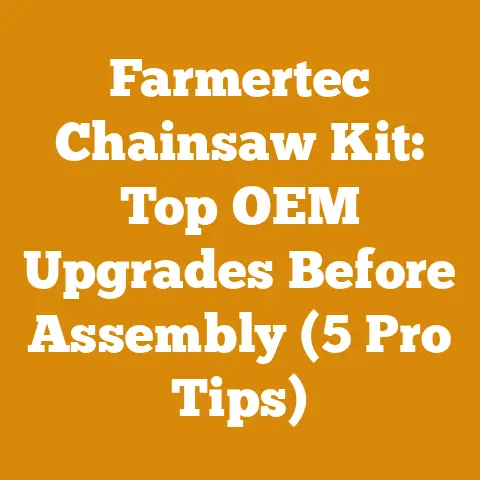Bandit 200+ Chipper Limits: Why It Won’t Take Over 8″ (Troubleshooting Tips)
Ease of maintenance is a cornerstone of efficient wood processing, and that’s something I’ve learned firsthand over years of wrestling with various machines. When things break down, especially in the field, it can be a real headache. That’s why I’m particularly fond of discussing the Bandit 200+ chipper. It’s a workhorse, but like any machine, it has its limits. One common frustration I’ve encountered, and I know many others have too, is the “Why won’t it take over 8 inches?” question. Let’s dive into troubleshooting this issue and unlock the full potential of your Bandit 200+ chipper.
Bandit 200+ Chipper Limits: Why It Won’t Take Over 8″ (Troubleshooting Tips)
The Bandit 200+ is a popular choice for a reason. It’s a solid, reliable machine, capable of handling a significant amount of wood. However, exceeding its stated capacity, usually around 12 inches for softwood and less for hardwood, can lead to problems. When you find yourself struggling to feed material larger than 8 inches, it’s time to investigate. I’ve been there, pulling my hair out, wondering why my chipper suddenly seemed underpowered. So, let’s roll up our sleeves and get to the bottom of this.
Understanding the Bandit 200+ Capabilities
Before we jump into troubleshooting, let’s be clear on what the Bandit 200+ is designed to do. It’s a powerful machine, but it’s not a miracle worker. It’s crucial to understand its limitations.
- Maximum Diameter: The official maximum diameter is a key factor. While it might be tempting to push the limits, consistently feeding oversized material will strain the machine and shorten its lifespan. Pay close attention to the wood type. Hardwoods like oak and maple require more power than softwoods like pine or fir.
- Horsepower Rating: The engine’s horsepower is directly related to the chipper’s capacity. A lower horsepower engine will struggle with larger diameter wood, especially hardwoods. Make sure your chipper’s engine is in good working order and producing its rated horsepower.
- Chipper Knife Condition: Dull or damaged chipper knives are a major culprit. They increase the force required to chip the wood, effectively reducing the chipper’s capacity.
- Hydraulic System Performance: The hydraulic system powers the feed rollers, which pull the wood into the chipper. A weak or malfunctioning hydraulic system will result in reduced feeding power.
Data Point: A study by the Forest Products Laboratory showed that dull chipper knives can increase energy consumption by up to 20% and reduce chipping efficiency by 15%.
Common Culprits: Why Your Chipper Might Be Underperforming
Okay, so you’re facing the 8-inch barrier. What’s likely causing the problem? Here’s a breakdown of the most common issues I’ve encountered and how to tackle them:
1. Dull or Damaged Chipper Knives
This is, by far, the most frequent reason I’ve seen for reduced chipping capacity. Dull knives require significantly more force to cut through the wood.
- The Problem: Dull knives increase the load on the engine and hydraulic system, making it difficult to chip larger diameter material. They also produce lower quality chips, with more splintering and uneven sizes.
- The Solution: Sharpen or replace your chipper knives regularly. How often depends on the type of wood you’re chipping and the amount of use. I generally recommend sharpening after every 40-50 hours of use, or sooner if you notice a decrease in performance. Always use the correct sharpening angle and follow the manufacturer’s instructions. Remember to balance the knives after sharpening to prevent vibration.
- Real Example: I was chipping a large pile of oak logs, and after about 30 hours, I noticed the chipper was struggling with anything over 6 inches. I sharpened the knives, and suddenly, it was back to effortlessly handling 10-inch logs. The difference was night and day.
2. Insufficient Hydraulic Pressure
The hydraulic system powers the feed rollers, which are responsible for pulling the wood into the chipper. If the hydraulic pressure is low, the rollers won’t have enough force to pull larger diameter material.
- The Problem: Low hydraulic pressure can be caused by a variety of factors, including a worn hydraulic pump, leaks in the hydraulic lines, or a malfunctioning pressure relief valve.
- The Solution: Check the hydraulic fluid level and top it off if necessary. Inspect the hydraulic lines for leaks and repair or replace any damaged lines. Use a hydraulic pressure gauge to check the pressure at the pump and at the feed rollers. If the pressure is low, the pump may need to be rebuilt or replaced. The pressure relief valve may also need adjustment or replacement.
- Case Study: A small logging operation I consulted with was experiencing significant downtime due to their Bandit 200+ chipper struggling with larger logs. After some troubleshooting, we discovered a leak in a hydraulic line leading to the feed rollers. Replacing the line restored the hydraulic pressure, and the chipper was back to full capacity.
3. Engine Issues
The engine is the heart of the chipper. If it’s not producing its rated horsepower, the chipper will struggle to handle larger material.
- The Problem: Engine problems can range from simple issues like a dirty air filter to more serious problems like a worn engine or faulty fuel system.
- The Solution: Start with the basics. Check the air filter and replace it if it’s dirty. Check the fuel filter and replace it if it’s clogged. Make sure the engine is getting enough fuel and that the fuel is clean. Check the spark plugs and replace them if they’re worn. If the engine is still running poorly, it may need to be tuned up or rebuilt by a qualified mechanic.
- Insight: I once spent an entire afternoon troubleshooting a chipper that was underperforming, only to discover that the air filter was completely clogged. A simple $10 air filter made a world of difference.
4. Feed Roller Adjustment
The feed rollers need to be properly adjusted to provide the correct amount of pressure on the wood. If the rollers are too loose, they won’t grip the wood properly. If they’re too tight, they can stall the engine.
- The Problem: Improper feed roller adjustment can lead to slipping, stalling, and reduced chipping capacity.
- The Solution: Consult the chipper’s manual for the correct feed roller adjustment procedure. Adjust the rollers until they provide a firm grip on the wood without stalling the engine.
- Best Practice: I always recommend starting with a slightly looser setting and gradually tightening the rollers until you find the sweet spot.
5. Wood Species and Condition
The type and condition of the wood you’re chipping can also affect the chipper’s performance.
- The Problem: Hardwoods like oak and maple require more power to chip than softwoods like pine or fir. Wet or frozen wood is also more difficult to chip.
- The Solution: Be aware of the limitations of your chipper and avoid trying to chip oversized hardwood logs. Allow wet wood to dry before chipping it. Avoid chipping frozen wood if possible.
- Wood Species Data: Oak requires approximately 30% more force to chip than pine of the same diameter.
6. Blocked Discharge Chute
A blocked discharge chute can create back pressure, making it harder to feed material into the chipper.
- The Problem: A blocked chute restricts the flow of chips, increasing the load on the engine and reducing chipping capacity.
- The Solution: Regularly inspect the discharge chute and clear any obstructions.
- Safety Note: Always shut down the chipper and disconnect the spark plug wire before clearing a blocked chute.
7. Clutch Problems
If your chipper has a clutch, a worn or slipping clutch can prevent the engine from transferring its full power to the chipper drum.
- The Problem: A slipping clutch reduces the amount of torque available to the chipper, making it difficult to chip larger material.
- The Solution: Inspect the clutch for wear and tear. Adjust the clutch according to the manufacturer’s instructions. If the clutch is worn, it may need to be replaced.
- Maintenance Tip: Regular clutch maintenance can extend its lifespan and prevent costly repairs.
8. Computer/Electrical Problems
Modern chippers often have electronic control systems. These systems can sometimes malfunction, leading to reduced performance.
- The Problem: Electrical issues can affect engine performance, hydraulic system operation, and feed roller speed.
- The Solution: Check the wiring harness for damage or loose connections. Use a multimeter to check the voltage and continuity of the electrical circuits. Consult a qualified electrician for more complex electrical problems.
- Insight: I once spent hours troubleshooting a chipper, only to discover a corroded ground wire was causing intermittent electrical problems. Cleaning the wire and tightening the connection solved the issue.
Advanced Troubleshooting: Digging Deeper
If you’ve addressed the common culprits and your chipper is still underperforming, it’s time to dig a little deeper.
1. Hydraulic System Analysis
A thorough hydraulic system analysis can help pinpoint hidden problems.
- Pressure Testing: Use a hydraulic pressure gauge to check the pressure at various points in the system. Compare the readings to the manufacturer’s specifications.
- Flow Testing: Use a hydraulic flow meter to check the flow rate of the hydraulic fluid. A low flow rate can indicate a worn pump or a blockage in the system.
- Leak Detection: Use a leak detection dye to identify hidden leaks in the hydraulic lines and components.
- Component Inspection: Inspect the hydraulic pump, cylinders, and valves for wear and tear.
2. Engine Dynamometer Testing
A dynamometer test can accurately measure the engine’s horsepower and torque output. This can help determine if the engine is producing its rated power.
- The Process: The engine is connected to a dynamometer, which measures the engine’s output at various speeds and loads.
- The Results: The dynamometer test will provide a detailed report of the engine’s performance, including horsepower, torque, and fuel consumption.
- The Analysis: Compare the dynamometer results to the manufacturer’s specifications. If the engine is not producing its rated power, it may need to be tuned up or rebuilt.
3. Chipper Drum Inspection
Inspect the chipper drum for damage, wear, and imbalance.
- The Problem: A damaged or imbalanced chipper drum can cause vibration, reduced chipping capacity, and premature wear on the bearings.
- The Solution: Inspect the drum for cracks, dents, and other damage. Check the balance of the drum using a balancing machine. Replace any worn or damaged bearings.
- Safety First: Always disconnect the spark plug wire and use proper safety precautions when working on the chipper drum.
4. Computer Diagnostics
If your chipper has an electronic control system, use a diagnostic scanner to check for error codes.
- The Process: Connect the diagnostic scanner to the chipper’s diagnostic port. The scanner will read any error codes stored in the control system’s memory.
- The Results: The error codes can provide valuable information about the cause of the problem.
- The Analysis: Consult the chipper’s service manual for a list of error codes and their corresponding troubleshooting procedures.
Preventative Maintenance: The Key to Long-Term Performance
The best way to avoid performance problems is to perform regular preventative maintenance.
- Daily Maintenance: Check the fluid levels, air filter, and chipper knives. Lubricate the moving parts. Inspect the hydraulic lines for leaks.
- Weekly Maintenance: Sharpen or replace the chipper knives. Check the feed roller adjustment. Inspect the clutch.
- Monthly Maintenance: Change the engine oil and filter. Change the hydraulic fluid and filter. Grease all bearings and pivot points.
- Annual Maintenance: Inspect the chipper drum for damage. Check the engine compression. Have the hydraulic system professionally inspected.
Data Point: A study by the Equipment Maintenance Council found that preventative maintenance can reduce equipment downtime by up to 25% and extend equipment lifespan by up to 30%.
Safety First: A Reminder
Working with a chipper can be dangerous. Always follow these safety precautions:
- Wear appropriate personal protective equipment (PPE), including safety glasses, hearing protection, gloves, and steel-toed boots.
- Read and understand the chipper’s operating manual before using the machine.
- Never operate the chipper under the influence of drugs or alcohol.
- Keep bystanders away from the chipper while it is in operation.
- Never reach into the chipper while it is running.
- Shut down the chipper and disconnect the spark plug wire before performing any maintenance or repairs.
- Be aware of your surroundings and watch for hazards such as overhead power lines and uneven terrain.
- Use proper lifting techniques to avoid back injuries.
- Store the chipper in a safe and secure location when it is not in use.
Choosing the Right Chipper for the Job
Finally, it’s worth considering whether the Bandit 200+ is truly the right chipper for your needs. If you consistently process larger diameter wood, you might need a larger, more powerful machine. Here are some factors to consider when choosing a chipper:
- Maximum Diameter: Choose a chipper with a maximum diameter rating that is at least 2 inches larger than the largest diameter wood you plan to chip.
- Horsepower Rating: Choose a chipper with a horsepower rating that is appropriate for the type of wood you plan to chip. Hardwoods require more horsepower than softwoods.
- Chipper Knife Type: Different chipper knife types are better suited for different types of wood. Disk chippers are generally better for hardwoods, while drum chippers are better for softwoods.
- Feed System: Choose a chipper with a feed system that is appropriate for the type of material you plan to chip. Self-feeding chippers are better for large, irregular pieces of wood, while gravity-feed chippers are better for smaller, more uniform pieces.
- Portability: Consider the portability of the chipper. If you need to move the chipper frequently, choose a towable model.
- Budget: Chipper prices can vary widely. Set a budget and choose a chipper that meets your needs without breaking the bank.
Industry Trend: There’s a growing trend toward more compact and portable chippers, driven by the increasing demand for urban wood recycling and small-scale forestry operations.
Troubleshooting in the Field: Quick Fixes
Sometimes, you need a quick fix to get you through the day. Here are a few tips for troubleshooting in the field:
- Carry Spare Parts: Keep a supply of spare parts on hand, including chipper knives, belts, hoses, and spark plugs.
- Tools are Your Friends: A basic tool kit is essential for making repairs in the field. Include wrenches, screwdrivers, pliers, and a multimeter.
- Cleanliness is Key: Keep the chipper clean and free of debris. This will help prevent problems and make it easier to identify potential issues.
- Listen to Your Machine: Pay attention to the sounds the chipper is making. Unusual noises can be a sign of a problem.
- Don’t Force It: If the chipper is struggling, don’t force it. Stop and troubleshoot the problem before you damage the machine.
- Use Your Network: Don’t be afraid to ask for help. Contact your local dealer or other chipper owners for advice.
The Sweet Sound of a Well-Oiled Machine
There’s nothing quite like the satisfaction of hearing a chipper running smoothly, effortlessly processing wood. It’s a testament to proper maintenance, careful operation, and a solid understanding of the machine’s capabilities. By following these troubleshooting tips and implementing a regular preventative maintenance program, you can keep your Bandit 200+ chipper running at peak performance for years to come. Remember, a little bit of effort goes a long way in preventing costly repairs and maximizing your productivity.
Final Thoughts: It’s More Than Just a Machine
Ultimately, wood processing is more than just a mechanical process. It’s about understanding the materials, respecting the equipment, and working safely and efficiently. Whether you’re a hobbyist, a small logging operation, or a firewood producer, the principles remain the same. By embracing best practices and continuously learning, you can achieve your goals and contribute to a sustainable future. And that, my friends, is something to be proud of.






